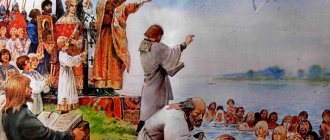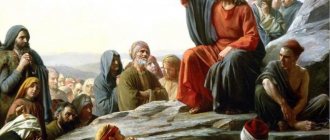Christianity: general characteristics (Lecture on the course “History of the World’s Religions”, Ph.D., Associate Professor, Elena Leonidovna Pavlova) [1:10:06] Gordon - Dialogues. No. 217. Informal Christianity Gordon - Dialogues: The Teachings of Christ
| Christianity Portal:Christianity | |
| Bible Old Testament New Testament Apocrypha Gospel Ten Commandments Sermon on the Mount | |
| Trinity God the Father God the Son (Jesus Christ) God the Holy Spirit | |
| History of Christianity Chronology of Christianity Early Christianity Gnostic Christianity Apostles Ecumenical Councils Great Schism Crusades Reformation | |
| Christian theology Fall · Sin · Grace Hypostatic union Redemptive sacrifice · Christology Salvation · Virtues Christian worship · Sacraments Church · Eschatology | |
| Branches of Christianity Catholicism · Orthodoxy · Protestantism Ancient Eastern churches · Antitrinitarians | |
| Criticism of Christianity Criticism of the Bible · Criticism of the Trinity Template: p·o·i | |
Christianity
, historically, is an Abrahamic religious tradition that arose along with the collapse of the Roman Empire and strengthened in European civilization through the efforts of the Christian “Church” - a long-lasting, branched international organization.
At the level of rituals and dogma, the Christian church replaced the pagan cults of the Mediterranean countries with the Judaic theme of the omnipresent God-punisher of the moral actions of every person.
Basics of Faith
Christianity, as a system of beliefs, is based on the concept of supernatural incorporeal beings - such as spirits, souls, angels, devils - and the complete superiority over all other beings of Jehovah - the God of the Jews, not inclined to personally address ordinary followers, but known through the penetration of literature and personal sermons from prophets, saints, priests, pontiffs and other righteous people. It is believed that the founder and spiritual leader of Christianity, Jesus Christ, was the most important of such authorities. If you pray correctly and follow the behavioral norms of Christianity, you can receive bonuses through the help of “spirits.”
Differences from Judaism are the rejection of many important rituals (Shabbat, kashrut and others) (not in all directions) and adherence to the rules of the Talmud, as well as a new understanding of the relationship between man and God (not a slave, but a son). Basic Christian principles - love for one's neighbor, mercy, observance of the 10 commandments.
The main tenets of Christianity
This religion is historical, which means its faith is based on the events described in the sacred letter of the Gospel. Four books of “evangelism” tell about the birth, life path, execution and resurrection of Jesus Christ.
The resurrection of Jesus Christ was truly good news: the apostles, the messengers of the risen Son of God, told the people about it for enlightenment and baptism. Resurrection is the guarantor of an infallible path that aims at victory over death, the life of the coming century.
Christianity preaches not only the immortality of the soul, but also the body. The resurrection will happen to everyone, but not everyone will be honored with life next to God in the Kingdom of Heaven, which means bodily resurrection is not a sign of imminent bliss. After the Second Coming, Jesus Christ will personally lead them to the Last Judgment. The purpose of the court is not to punish sinners, but to select. People are imperfect, cowardly and evil - unworthy of the original image of creation.
The embodiment of happiness and rapture in Christianity are people who have renounced earthly blessings in the name of the Lord: peacemakers, the poor, the merciful. Followers of the Son of God are not afraid of reproach and expulsion.
Christianity teaches the ideal purpose of man in the world, the dominance of the spirit over the mortal, the achievement of harmony between the sacred and matter, and conveys a small part of God’s lofty plan.
Varieties
In modern Christianity, the following major trends are distinguished, which are divided into many small ones: Catholicism, Orthodoxy, Protestantism.
Catholicism
Orthodoxy
Orthodoxy
- a Christian community consisting of a number of theologically united local (autocephalous, autonomous, etc.) churches that are in Eucharistic communion with each other. In addition to canonical Orthodoxy, there are a number of unrecognized Orthodox churches, for example, the Ukrainian Orthodox Church of the Kyiv Patriarchate, the Macedonian Orthodox Church, the Old Believers, the Russian True Orthodox Church (catacombs), etc.
Protestantism
Protestantism
- one of the most widespread trends in Christianity, separated from Catholicism during the Reformation in the 16th century (Lutheranism, Calvinism, etc.) and as a result of further internal division (Adventists, Baptists, Methodists, etc.). There are churches and societies of Protestants of a national or local nature all over the world, some reaching tens of millions of believers. There is no center of Protestantism; organizationally, Protestant local churches are united into regional organizations, which, in turn, form worldwide associations of churches.
Some religious movements that emerged from Protestantism and identify themselves as Christian - Mormons, Moonies, Jehovah's Witnesses - are not recognized as such by the confessions of the Christian world for differences in the understanding of basic Christian doctrines (the dogma of the Trinity, another Christology).
Gnosticism
Gnosticism advocates the complete liberation of Christianity from the Jewish heritage, considering Christianity a philosophical or mystical system of antiquity. All other movements descended from the Apostle Paul, such as Catholicism, regardless of the number of their followers, are perceived by Gnostics as a mixture of Christianity and Judaism (“Judeo-Christianity”)[1].
Jesus Christ. The story of life, death and resurrection
The essence of Christianity lies not only in its teachings, but in the very belief in the divinity of Christ. Almighty God sent his child to earth. Jesus faithfully preached throughout the cities of Judea and received the nickname “Son of the Living God.” The Jewish authorities were zealous for the purity of teachings and opened a hunt for the peaceful wanderer.
The glory of Christ walked among people day and night. On the eve of Passover in the 30th year, Yeshua reminded Judea of himself. A week before the celebration, he resurrected the dead Lazarus.
The indignation of the high priest was unimaginable and led to the fact that Christ was recognized as a dangerous preacher. On Thursday evening, Jesus was captured, at the instigation of the traitor Judas, and executed the next day. According to the laws of Judea - for blasphemy and rebellion.
Pontius Pilate, the Roman governor, conducted proceedings in the case of Yeshua and was even ready to release the anointed one, but Caesar’s friends did not allow him to do so. The right to release Christ in honor of Easter was neglected. Israel rejected Jesus.
The news of Jesus' resurrection swept Rome and later the entire empire.
Criticism
Christianity has been and is being criticized by philosophers (for example, Nietzsche) from the standpoint of competing philosophical platforms, by Jews and Muslims from the standpoint of their own religions, and by atheists.
Moral criticism of Christianity (mainly Catholicism and Orthodoxy) includes aspects such as:
- persecution of non-Christians, civil wars in the late Roman Empire.
- persecution of scientists and thinkers.
- the fires of the Inquisition in the west and Nikonianism in the east.
- position of the Holy See during the Second World War.
- Jewish pogroms.
- much more.
What is Christianity? Definition of this concept
Christianity is a religious doctrine based on faith in the son of God - Jesus Christ. Christianity in our time is the largest religion in the world. In terms of numbers, this world religion includes about 2.5 billion adherents.
3 main types (directions) in Christianity
- Orthodoxy;
- Catholicism;
- Protestantism. For a brief description of these types, see the article below.
Already at the beginning of the 5th century, the Christian faith came to every state. The Orthodox became an elite with an enviable position and influence. With popularization came persecution. Caesar Galerius called religion an “infection” and became the culprit of harsh mass repressions. Thousands of martyrs died, but the persecution eradicated itself. Governors and military men themselves resorted to Christianity, and the measures taken did not add to the order of the empire. Galerius gave the go-ahead for the existence of the faith of Jesus. Only in 311 did it receive official status. Now the rulers themselves became adherents of the religion, spreading it to the masses, making it world famous and significant.
The time stream and the people themselves divided the original Christianity into Catholicism, Protestantism and Orthodoxy. Numerous reforms and restructurings of religion in states have made adjustments to directions, but they are united by one great plan and creed.
Key points of ancient religion: the schism of the Church
The reason for the split of Christianity into three conflicting faiths was the debate about the union of the divine and human essence of Jesus Christ into one person. Due to cultural and historical differences, there was constant debate among followers about the need to choose one official version. The growing conflict led to a division into denominations, each of which adhered to its own version.
In 1054, Christianity split into Orthodox and Catholic branches. Attempts to unite them again into one Church were unsuccessful. An attempt at unification was an agreement on the unification of churches on the territory of the Polish-Lithuanian Commonwealth - the Union of Brest, signed in 1596. But in the end, the conflict between faiths only intensified.
Anthropology: the origin of man and his purpose
Initially, man was created in his image of God, and possesses his power. The originals Adam and Eve were similar to their Creator, but they committed the original sin - they succumbed to temptation and ate an apple from the tree of knowledge. From that moment on, man became sinful, and his body was perishable.
But the human soul is immortal and can go to Paradise, where God is waiting for it. To be in Paradise, a person must atone for his sin through physical and spiritual suffering. In the Christian understanding, evil is temptation, and good is humility. Suffering is a way to fight evil. Ascent to God and return to one's original essence is possible only through humility. It leads to freedom of spirit and understanding of the true essence of life. For people who succumb to temptation, Hell awaits - the kingdom of Satan, in which sinners eternally suffer, paying for their sins.
Prerequisites and reasons for the adoption of Christianity in Rus'
As a result of the crazy campaigns of Svyatoslav, who stubbornly refused to listen to the admonitions of his mother, Princess Olga, and accept Christianity, many people died, including from the elite of government. These gaps had to be filled, if only in order to be able to further strengthen the territorial integrity of Rus'.
It was obvious to Vladimir that neighboring Byzantium , although in less favorable economic conditions, was hundreds of times stronger politically. He believed that this was largely determined by the prevalence of Christianity, which had long been endowed with the official status of a single religion.
And this is understandable, because in a pious country where everyone “submits” to one god, it was impossible to imagine that anyone would rebel against the authority of the emperor or the dominant church.
For the ruler of Rus', the reason here was as pragmatic as possible: it is much easier to govern a people united by one faith than a people scattered due to many pagan cults.
Moreover, in light of the international political situation of that time, the prevalence of paganism in itself could lead to the isolation of the state, since one half of the world had long been Christian, and the other Muslim.
In addition, Vladimir, noticeably tired of endless military campaigns, had other reasons for accepting Christianity :
- personal - the prince passionately desired to marry the beautiful Anna, the sister of Vasily II, who was at that time the emperor of Byzantium;
- social - Christianity as a worldview system is significantly more complex than paganism, and this inevitably leads to increased social heterogeneity both in society and in the spiritual needs of the ruling elite. Therefore, monotheism was more appropriate than polytheism.
So, Vladimir made a difficult choice and decided in favor of Christianity, however, due to the specifics of the baptismal ritual, as well as the ease of movement of the prince’s supporters along the rivers, the first large Christian communities arose only along the banks of the Dnieper and Volkhov. At the same time, the central territories still remained pagan.
For example, in Novgorod the pagans put up fierce resistance , which was suppressed by force. There were particular difficulties with the followers of paganism who lived on the Oka and Volga, in the Rostov land. In these places, the old beliefs turned out to be incredibly tenacious and extremely persistent.
Ancient Rus' and the adoption of Christianity
The baptism of Russia is associated with the name of Prince Vladimir , but Christians appeared among the Slavs much earlier. Thus, the first Russian diocese appeared in Tmutarakan back in 867, since the local population had already partially converted to Christianity.
Before Vladimir, the third prince of Kiev, the most iconic figure in state affairs was the decisive, wise and very talented ruler Princess Olga .
In 955, 10 years after the death of her husband Igor Rurikovich, Olga renounced paganism, took her confessor Father Gregory with her and went to Constantinople, where she accepted the new faith.
In the 10th century, the most significant number of Christians was noted among the Varangians, and in Kyiv, not far from the embankment, one of the first Orthodox shrines in Rus', the wooden Elias Church, had been “working” for several years.
The chronicles mention that the persecution and reprisals of pagans against Christian Varangians could have pushed Vladimir to the need for reforms.
The legend tells of religious embassies that invited the prince to accept their faith. There were about a dozen such embassies with proposals, but only four were key:
- Catholicism;
- Judaism;
- Islam;
- Orthodoxy.
The choice of any of them not only meant a change in the way of life, but also promised certain political preferences in negotiations with fellow believers. Based on the results of lengthy fabrications, Vladimir gave preference to the Byzantine proposal. Why?
What are the sacraments
There is a unique concept in the Christian faith - sacrament. It arose as a definition of a special action that cannot be attributed to either rites or rituals. Only God can know the true essence of the sacrament; it is not accessible to man due to his imperfection and sinfulness.
The most important sacraments: baptism and communion. The first is the initiation of the believer, introducing him into the number of God-pleasing people. The second is connecting with the essence of Jesus by eating the sacred bread and wine, symbolizing his flesh and blood.
Orthodoxy and Catholicism recognize five more sacraments:
- anointing;
- ordination;
- repentance;
- marriage;
- Unction.
Protestantism denies the sacredness of these phenomena. This branch is also characterized by a gradual abandonment of asceticism, as the only way for a person to get closer to the divine essence.
The role of the monarchy in the formation of religion
The official state religion of Rome was paganism, which involved the deification of the current emperor. The new teaching was received with hostility. Persecution and prohibitions have become part of the history of religion. Christianity was forbidden not only to profess, but also to remember its existence. Preachers were subjected to torture, life imprisonment or the death penalty. But adherents of Christianity revered them as martyrs, and every year Christianity spread more and more actively.
Already in the 4th century, Emperor Constantine was forced to recognize the new belief. The pagans staged riots to protest against the emperor's interference in the affairs of the Church. Christians went into the desert and organized monastic settlements there. Thanks to this, nomads learned about the new religion. Christianity gradually spread to other countries.
The emperor's power was weakening. The abbot of the Roman Church, the Pope, declared himself the sole representative of the religion, and the rightful ruler of the Roman Empire. Attempts to find a balance between the desire for power and the preservation of the Christian way of life became the main moral dilemma for representatives of high church rank.
How Christianity became the state religion
Until the Council of Nicea, convened in 325, Christians in the Roman Empire were persecuted: their property was taken away, churches were set on fire. The persecution especially intensified under the emperor Diocletian (about 245-316). Diocletian wanted to revive the old pagan traditions and transform them into a kind of state religion. However, his anti-Christian policy turned out to be untenable. It was put an end to by Constantine I (about 285-337), who became emperor after Diocletian.
The Roman Empire had a well-organized army and a well-functioning mechanism of government. The common economic space provided a decent level of well-being. Civil rights granted to all inhabitants of the empire contributed to strengthening the cohesion of the population. There was no unity only on the issue of religion.
Council of Nicaea
Three-meter head of Emperor Constantine
To put an end to the long-standing religious dispute between Bishop Alexander and Presbyter Arius, Emperor Constantine invited Christian clergy on June 19, 325 to the Council in Nicaea (now Iznik, a settlement in Turkey, in the vicinity of Istanbul).
The purpose of the Council, in which 318 bishops, as well as many presbyters and deacons arrived, was not at all to elevate Christianity to the rank of state religion, but to resolve religious differences for the sake of stabilizing the Roman Empire.
The Council, which became the first Ecumenical Council of the Christian Church, lasted more than two months. After long debates, Emperor Constantine I took the side of Bishop Alexander and his like-minded people. The Council proclaimed the divinity of the Holy Spirit and his equality with the Father and the Son. Arianism was condemned. With the establishment of the basic doctrines of Christianity and the signing of the formula of the Christian confession (the so-called Nicene Creed), the persecution of Christians ceased.
Manifesto of Faith
Soon the adherents of Christianity had a new reason for celebration. On February 27, 380, the Eastern Roman Emperor Theodosius I the Great (347-395), in the presence of the Western Roman Emperor Valentinian II (371-392) and his half-brother, co-ruler Gratian (359-383), signed the Edict of faith, proclaiming Christianity as the state religion and prohibiting the practice of pagan rituals.
Roman coin depicting Theodosius I the Great
The edict, called Cunctos populos, not only provided Christianity with a special status, but also opened the way for the persecution of heretics and infidels. In it, Emperor Theodosius commanded all peoples under his authority to profess faith according to the Nicene Symbol, adopted at the First Ecumenical Council.
According to the edict, in the Roman Empire every person had to profess the faith in its form, which was preached by St. Peter in Rome and which was followed by men of apostolic holiness - the Roman Bishop Damasus and the Alexandrian Bishop Peter. This meant the idea of God as an unmerged and indivisible Holy Trinity - Father, Son and Holy Spirit.
“We command the followers of this doctrine,” the edict said, “to be called Orthodox Christians, but we consider the rest to be mentally ill and insane, condemn them to bear the ignominy of heretical teaching, and we do not attribute their meetings to the name of churches. In addition to the verdict of divine justice, they will have to suffer severe punishments, which our government, guided by heavenly wisdom, will choose to subject them to.”
Symbiosis of culture and religion
Just as Christians and Jews were once persecuted in the Roman Empire, so now the pagans were subjected to severe persecution here. The cult rituals of the Gentiles were equated with high treason. Pagan temples and sanctuaries were mercilessly destroyed. The Delphic Oracle, a legendary oracle at the Temple of Apollo in the ancient Greek city of Delphi, also became a victim of the zealots of the “true” faith.
And yet, February 27, 380 is an epoch-making date in European history. After all, it was on this day that a symbiosis of Judeo-Christian roots and Greek-Roman ancient culture was formed.
The ancient history of Greece and Rome and the Judeo-Christian religious teachings had a decisive influence on the development of Europe - both in a positive and negative sense. For in subsequent centuries, the Christian cross symbolized not only help to the poor, sick and suffering. The killings of dissidents and “apostates” were also carried out in the name of Christ.
Authors: Matthias von Helfeld / Natalia Koroleva Editor: Gleb Gavrik








